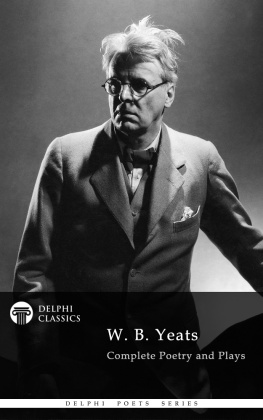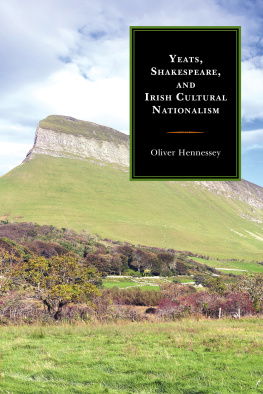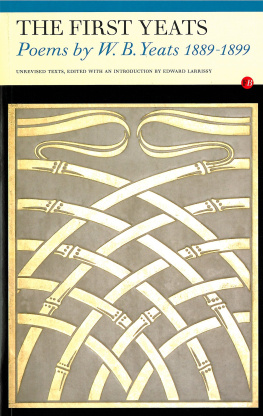
UNDER THE MOON
THE UNPUBLISHED EARLY POETRY
William Butler Yeats
EDITED BY GEORGE BORNSTEIN
SCRIBNER
New York London Toronto Sydney

SCRIBNER
Rockefeller Center
1230 Avenue of the Americas
New York, NY 10020
Copyright 1995 by Anne Yeats and Michael Yeats
Introduction and editorial materials copyright 1995 by George Bornstein
All rights reserved, including the right of reproduction in whole or in part in any form.
S CRIBNER is a trademark of Simon & Schuster Inc.
www.SimonandSchuster.com
Designed by Hyun Joo Kim
Manufactured in the United States of America
3 5 7 9 10 8 6 4 2
Library of Congress Cataloging-in-Publication Data
Yeats, W. B. (William Butler), 1865-1939.
Under the moon : the unpublished early poetry / by William Butler Yeats ; edited by George Bornstein.
p. cm.
Includes bibliographical references.
I. Bornstein, George. II. Title.
PR5904.U5 1995
8218dc20 95-8445
CIP
ISBN: 0-684-80254-6
eISBN 978-1-451-60300-2
To Anne, Michael, and Grinne Yeats
CONTENTS
INTRODUCTION: BECOMING W. B. YEATS
Under the Moon makes available for the first time in book form reading texts of thirty-eight unpublished early poems by the major modern poet W. B. Yeats. Gonne. The final few lyrics belong to the elaborate manuscript books, one of them a love token for Gonne, that Yeats constructed before the appearance of his first collected edition, the Poems (1895) volume, at the age of thirty. When the manuscripts begin, Yeats was a private figure, a talented and sensitive adolescent. By the time that they end, he had become a public figure, already recognized both at home and abroad as the leading Irish poet of his generation and within Ireland as a controversial leader of the cultural nationalists seeking to recover (some would say invent) traditional materials for the creation of a modern Irish art and identity.
That process of self-fashioning followed the outlines of a perceptive comment with which Yeats began a retrospective essay composed in his mid-fifties called If I Were Four-and-Twenty. There he wrote of his youth:
One day when I was twenty-three or twenty-four this sentence seemed to form in my head, without my willing it, much as sentences form when we are half-asleep: Hammer your thoughts into unity. For days I could think of nothing else, and for years I tested all I did by that sentence. I had three interests: interest in a form of literature, in a form of philosophy, and a belief in nationality. None of these seemed to have anything to do with the other, but gradually my love of literature and my belief in nationality came together. Then for years I said to myself that these two had nothing to do with my form of philosophy, but that I had only to be sincere and to keep from constraining one by the other and they would become one interest.
The manuscripts in the present volume display that development clearly. In the earliest ones, like the long narrative Sir Roland, Yeats appears primarily as a derivative poet of late Victorian literary convention, often imitating still earlier eras. Those from the later 1880s, like The Outlaws Bridal, show the fusion of Yeatss literary interests with his political ones, particularly in the Irish settings and subject matter that had begun to pervade his work. Finally, the poems of the 1890s, like To a Sister of the Cross and the Rose, display the merging of the already-joined literary and political interests with esoteric philosophies of a theosophical or Rosicrucian sort. The certain newness provided by both their subject matter and their technique reveals Yeats on the cusp of developing the modern style that he would make famous.
While one may track that progress through Yeatss published poetry as well, the manuscripts used for Under the Moon allow a look behind the scenes, at what was going on in Yeatss poetic workshop during this important period. Although these poems are not known to have been published by Yeats, it is possible that some of the more polished among them did appear in fugitive publications of late nineteenth-century Ireland. For example, had a printed text of The Protestants Leap not been discovered recently in a fragmentary copy of The Gael (the magazine of the Gaelic Athletic Association) from 1887, that poem would have been part of the present edition. of the lyrics included here got as far as being set in proof. But Yeats chose to leave the majority of the poems unpublished. As such, they stand in the same relation to his individually published poems that those poems do to his single volumes of verse, and that those single volumes do to the collected ones. At every stage, Yeats constructed a self by inclusion, exclusion, and revision out of a wide range of available materials. Reading the early stages of that process can both illuminate the beginning of a major poetic career and add insight into the greater achievements that were to follow.
I am persuaded that our intellects at twenty contain all the truths we shall ever find, but as yet we do not know truths that belong to us from opinions caught up in casual irritation or momentary fantasy, confessed Yeats in his Autobiographies. Usheen (Oisin) and Patrick, the chief characters in The Wanderings of Oisin, represent such antinomies as active versus contemplative life, pagan versus Christian Ireland, and acceptance of the world versus transcendence of it. Those same contrasts, along with many others, appear in the poems here, as they do throughout Yeatss work.
Images and symbols that he would later make famous arise here, too, like the questers in Sir Roland, the tower of Tower wind-beaten grim, or the symbolic geography of fountains, dells, boats, and sun and moon that dot the poems. The bird imagery of several lyrics finds its most striking anticipation of the later work in the golden bird that adorns the cover of an album containing nine of the poems and that inevitably suggests the more famous golden bird of Yeatss two Byzantium poems. Not surprisingly, the forms of the early verse anticipate those used in several of Yeatss greatest achievements. The experimentation with sonnet structure in Behold the man or The Veiled Voices would lead to such great mature sonnets as Leda and the Swan or Meru. Yeatss fondness for dialogue poems here runs the gamut from relatively simple interchanges in The Magpie and A soul of the fountain to the full-blown ones of Loves Decay. He would later compose numerous major poems in dialogue, including The Mask, Ego Dominus Tuus, and A Dialogue of Self and Soul. And the preference for eight-line units that underlies A Prayer for My Daughter or The Municipal Gallery Re-visited appears as early as The Magpie and The Outlaws Bridal.
Yeats composed with considerable difficulty, and even these
With his literary interests well-established, Yeats was soon to join them with Irish nationalism. Up until 1885 his existence had oscillated among Dublin, where he was born and sometimes lived, London, where his father, the painter John Butler Yeats, had moved the family in search of commissions, and the west-country port of Sligo, where his mothers relatives lived. Unsure of his ability to pass the entrance examinations for the Anglo-Irish citadel of Trinity College Dublin, Yeats in 1884 had entered instead the Metropolitan School of Art. But his literary interests continued strong, taking a decisive turn when he met the exiled Irish patriot John OLeary shortly after OLearys return to Ireland the following year. Yeats maintained consistently that the event had changed his art and his life. It was through the old Fenian leader John OLeary I found my theme, he recalled in the late essay A General Introduction for My Work. His long imprisonment, his longer banishment, his magnificent head, his scholarship, his pride, his integrity, all that aristocratic dream nourished amid little shops and little farms, had drawn around him a group of young men.
Next page







